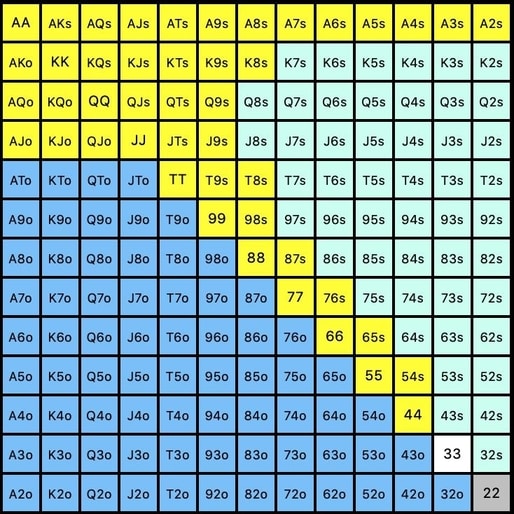Cbet Poker Signification
The continuation bet or 'c-bet' in no-limit hold'em is a frequently chosen action made by players who have taken the preflop initiative by raising. Noun When a player bet out or raised during a prior betting round, the act of betting out again. ADDITIONAL INFORMATION: If a player has represented a strong hand by making a bet or raise in a prior round, making an additional bet may represent that the hand is still strong even with additional cards available. This may induce opponents to fold. Every skilled poker player has the c-bet (short for “continuation bet”) in their arsenal. C-betting capitalizes on two crucial facts: The preflop aggressor usually has the strongest range of any player in the hand. This is a discussion on What is a c-bet? Within the online poker forums, in the Learning Poker section; I just read on an old post. A guy said he would take on a limper with j10 and then trap them.
What is a continuation bet? The continuation bet refers to the bet we make on the flop apart raising pre-flop. It's basically a continuation of our aggression pre-flop.Example of a continuation bet:
 Many may know what the continuation bet (C-Bet) is but might not necessarily know when to use it. Some players will c-bet 100% of the time and some players will rarely c-bet but finding the right balance is the key to mastering this skill. Essentially, you need to make sure that you don't become exploitable at the tables therefore mixing up your game
Many may know what the continuation bet (C-Bet) is but might not necessarily know when to use it. Some players will c-bet 100% of the time and some players will rarely c-bet but finding the right balance is the key to mastering this skill. Essentially, you need to make sure that you don't become exploitable at the tables therefore mixing up your game is going to keep your opponents guessing and be profitable in the long term. Some of the following examples will help you establish when to c-bet, when not to c-bet and why you're c-betting.
is going to keep your opponents guessing and be profitable in the long term. Some of the following examples will help you establish when to c-bet, when not to c-bet and why you're c-betting. Trying to get a c-bet through in a multi-way pot is extremely difficult and this is a typical situation where you need to adjust your c-betting range. With multiple opponents in the pot, you should rarely be c-betting as a bluff as more often than not one of your opponents will have connected with the flop. For example, we raise pre-flop with A♥ Q♠ and three players call heading into the flop. The board comes down 8♥ 9♠ 4♦, this board isn't great for us but will have hit our opponents range a good amount of the time therefore a c-bet is going to be called too much of the time for us to make a profit. Additionally, you'll find yourself making desperate bets on later streets to try and push your opponents of their hands. Remember, it's fine to give up a hand that you've raised pre-flop, money saved is money earned.
In this scenario, I would advise only c-betting your value hands especially with four or five players in the pot. Majority of the time your opponents will have weaker hands that have connected with the flop and this is an opportunity for us to extract value right away. For example, we raise pre-flop with A♥ A♦ and four players call heading into the flop. The board comes down 7♥ 5♠ K♦, this is a perfect board for us to be c-betting as majority of the time it will have connected with one of our opponents and we can start to build the pot and get value from worse hands.

C-betting on draw heavy boards is a lot more about the size of your bet especially if you are betting for value and protecting your hand against draws. It's often in bad beat stories that the phrase 'he rivered a flush to knock me out' is used and not only is this a luck factor but giving your opponent the right price to call with a draw is your own mistake. Using a different c-betting size on a variation of boards is definitely something you should be introducing to your game. However, balancing this is even more vital, if you start to only bet bigger on wet boards with your value hands then your opponents will adapt quickly and will know when to fold against you.
An example of balancing your c-betting on draw heavy boards is as follows:
With K♥ K♦ on a board of 7♥ 8♠ T♥, your c-bet if you decide to do so should be around 55-65% of the pot, this way we will be charging our opponent more to draw which will be more profitable for you in the long term.
With A♥ J♠ on a board of 6♠ 5♠ 9♥, if you decide to c-bet this board I would still bet around 55-65% of the pot, this way we charge our opponents to draw and can take the pot on a later street if our opponent plays the hand passively when drawing hands will have missed. Also, it balances our range as we would be doing this with an over pair to the board and our bluffs which will keep our opponents and work in our favour when we have big hands.
Remember, whilst it's important to focus on our bet sizing and be consistent, we also need to balance therefore c-betting may not always be the best thing to do in every scenario.
C-betting against the blinds is very dependent on the player and what hands they seem to be peeling from these positions. If you have enough information then playing against your regular opponent should be fairly straight forward. As a default, the small blind is a position where opponents are likely to defend a lot of broadway hands and small pairs that they might not necessarily think are strong enough for 3-betting or decide to air on the side of caution and play a smaller pot. This is only a guideline against opponents who we may not have as much information on, therefore we can use this as brief information when deciding on whether to c-bet a flop or not. In regards to the big blind, a typical range for an unknown player is a lot of suited connectors and small pairs especially in a multi-way pot. In general, the big blind is going to peel a wide range of hands from this position as they already have a good portion of chips invested in the pot. Therefore, as a guideline you will be able to identify whether to c-bet specific boards based on a brief idea of typical hands the big blind will defend.
For example:
Cbet Poker Significado
With A♥ 5♠ on a board of 2♠ T♠ Q♥, against an unknown player in the small blind, majority of the time checking back this board and re-evaluating the turn is perfectly fine. The board is going to connect with the small blinds range a good amount and we don't that much equity therefore we can save chips in this situation.
With 2♥ 2♠ on a board of A♥ 9♠ 5♥, against an unknown player in the small blind, c-betting here would be a much better option as worse pairs may fold to one bet and we can take the pot down easily against broadway hands which have missed the flop. However, if our opponents were to call one street with better pairs, we can represent the A on a later street as it hits our range much more than the small blind. Therefore, thinking about our perceived range in this scenario will result in better hands folding on later streets.
 With K♠ Q♠ on a board of 9♥ 8♦ 3♥, against an unknown player in the big blind, this is a scenario where checking would be more optimal than to c-bet. This board is going to connect with the big blinds defending range a lot of the time, therefore, we are likely to get called a good amount of the time in this spot with very little equity in the pot.
With K♠ Q♠ on a board of 9♥ 8♦ 3♥, against an unknown player in the big blind, this is a scenario where checking would be more optimal than to c-bet. This board is going to connect with the big blinds defending range a lot of the time, therefore, we are likely to get called a good amount of the time in this spot with very little equity in the pot.